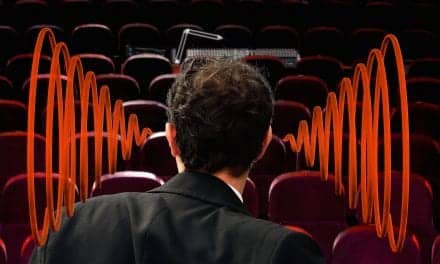A longtime audiologist shares how patients like his nonagenarian client stand to benefit from the new Auracast assistive listening technology in multiple situations.
By Steven Malawer, CCC-A, FAAA
Imagine this: Larry lives in New York City and has severe hearing loss. He works in finance and relaxes by going out to dinner and seeing the occasional Broadway show with his wife. Only he dreads the theater because he never knows how well the hearing loop and infrared accessibility systems there will work. Some theaters only have infrared headphones to lend out and do not offer a loop system.
Larry hears well with his hearing aids and connects them directly to his smartphone, using Bluetooth technology, to hear phone calls and adjust for volume and sound quality. However, his hearing loss is so severe that he cannot use the infrared headphones alone; they are not strong enough. In fact, during Broadway shows, he is forced to hold the infrared earphones close to his behind-the-ear hearing aids for the duration of the performance while making sure he does not create acoustic feedback (a whistling sound that others can hear). It’s uncomfortable, annoying, and the sound still isn’t great. (Let’s not even mention the cost of the tickets.)
So, what’s Larry to do?
With the introduction of Auracast broadcast audio, maximizing the use of hearing devices in both public and private spaces will be much easier. But to express how helpful it will be for power hearing aid users in particular, let me first share how difficult it has been for Larry and patients like him until now.
MacGyvering a Solution
When I first met Larry, he wore a pair of top-of-the-line power RICs (receiver-in-canal style) hearing aids with custom power receivers (speakers) but there were no telecoils (T-Coils) in his hearing aids. He had to use a separate assistive listening wireless accessory (ALWA) with a built-in T-coil to interface with standard telephones and hearing loop systems.
A T-coil is—simply put—a tiny electromagnet located inside the hearing aid. It operates by picking up magnetic leakage from a telephone receiver or from a wire loop installed in a room or hall. The amplified signal is transmitted along with the usual audio signal transmitted to the house speakers out to the audience.
Infrared assistive technology has been available in theaters and for use with TVs for several decades. In theaters, the audio signal is sent to the house speakers (and to the infrared audio transmitter) out to the audience.
Sennheiser made two types of infrared receiver units. One was the under-the-chin earphones familiar to anyone who has used them at a Broadway show. The other unit was a small, clip-on receiver with an earphone jack to which any set of earbuds or headphones could be plugged in. My colleague from NYC Hearing Associates and I located the last four remaining infrared clip-on units and purchased them from Sennheiser before they discontinued them. We decided to see if we could MacGyver the infrared receiver with an ALWA remote hearing aid microphone and provide a “gadget” for Larry to use.
We had access to a Broadway theater and took a duplicate set of his hearing aids along with the “gadget” and went to work with the sound engineer. We sat in the empty theater while the engineer played music, and were able to successfully access the infrared signal as well as the loop signal through the unit. Larry could now attend a show and stream audio from either the infrared receiver or T-coil loop into his hearing aids.
There was, however, a downside to this experiment. The “gadget” was a lot of technology, even for a savvy 90-year-old like Larry. We later simplified it by getting a new set of hearing aids with an integrated T-coil and a separate “neck loop” to plug into the infrared clip unit. That way Larry could easily access his T-coil if the theater had a loop and, if not, he could separately use his ALWA and send the infrared signal right into his hearing aid. This was the best we could do with the technology available in 2023.
A New, Better Alternative
But now is the time for power hearing aid users to celebrate with the introduction of Auracast broadcast audio. Auracast is a new high-quality assistive listening system that will transmit a direct audio input into any Auracast-enabled hearing aid or other hearing device. Larry, and others like him, can seamlessly enjoy Broadway shows, movies, lectures, airport announcements, and everything else broadcast by an Auracast transmitter simply by pressing a button on their hearing aid or smartphone app. Auracast technology will open a new world of accessibility for power hearing aid users by streaming audio signals directly into their hearing aids without additional “gadgets.”
The power user will hear the signal of interest as clearly as it is meant to be heard, and will be able to take advantage of the amplification strategies set in place by their hearing care professional during the initial programming of the aids. The user can also adjust the sound quality of the stream themselves by using the hearing aid control app on their smartphone.
It has been a difficult journey for people with severe hearing loss to enjoy the simple pleasure of clear hearing in theaters, movie theaters, lecture halls, airports, bus terminals, train stations, and more. But the new Bluetooth Auracast listening system, using Bluetooth LE technology, is a game changer.
Auracast at Home
And what about a person’s home TV? Clinical audiologists and hearing aid dispensers are often frustrated with their patients’ less-than-enthusiastic results hearing dialogue from their own television. The innovation of large, flat screen technology has left little room for the TV speakers, which are mainly relegated to the rear or bottom of the set. (I often describe this to my clients as listening to someone talk while facing their back.)
Many TVs are now sold with sound bars, usually at an additional cost, to place the speakers out front for enhanced clarity of speech. Power hearing aid users are often encouraged to purchase additional assistive technologies in the form of dedicated, wireless hearing aid streamers that are connected to one specific TV, sending the audio directly into the hearing aids. For some, it is a complicated installation and involves additional expenses that increase the cost of the hearing aids by hundreds of dollars. Not only that—a separate device is necessary for each TV in the household.
Auracast for TV will make it better and easier to connect, and to hear all television sets in the household without additional hardware or costs. And, as more TVs are equipped with Auracast transmitters, the power user will be able to visit friends and relatives and hear the TV clearly without bringing accessories with them or having to rely on captions (as many do).
Auracast broadcast audio is one of the most exciting assistive hearing technologies introduced during my 45 years as a practicing audiologist. I look forward to helping Larry, and other people who wear powerful hearing aids, to enjoy the benefits of better hearing with this new technological advancement.
Steven Malawer, CCC-A, FAAA, is a licensed audiologist in New York and Connecticut with almost 50 years of experience helping people to hear better. He attended the Hearing Science Program at the City University of New York under the tutelage of Professors Tonndorf, Studebaker, and Levitt where he developed an interest in physiologic acoustics and hearing aid amplification strategies. He recently worked for Apple involved with research in spatial audio and is currently developing a new hearing aid fitting protocol concerned with the identification and amelioration of spatial hearing loss to help people hear better in noise. He can be reached at [email protected].
Featured image: Photo 10100951 © Brian T. Young | Dreamstime.com





